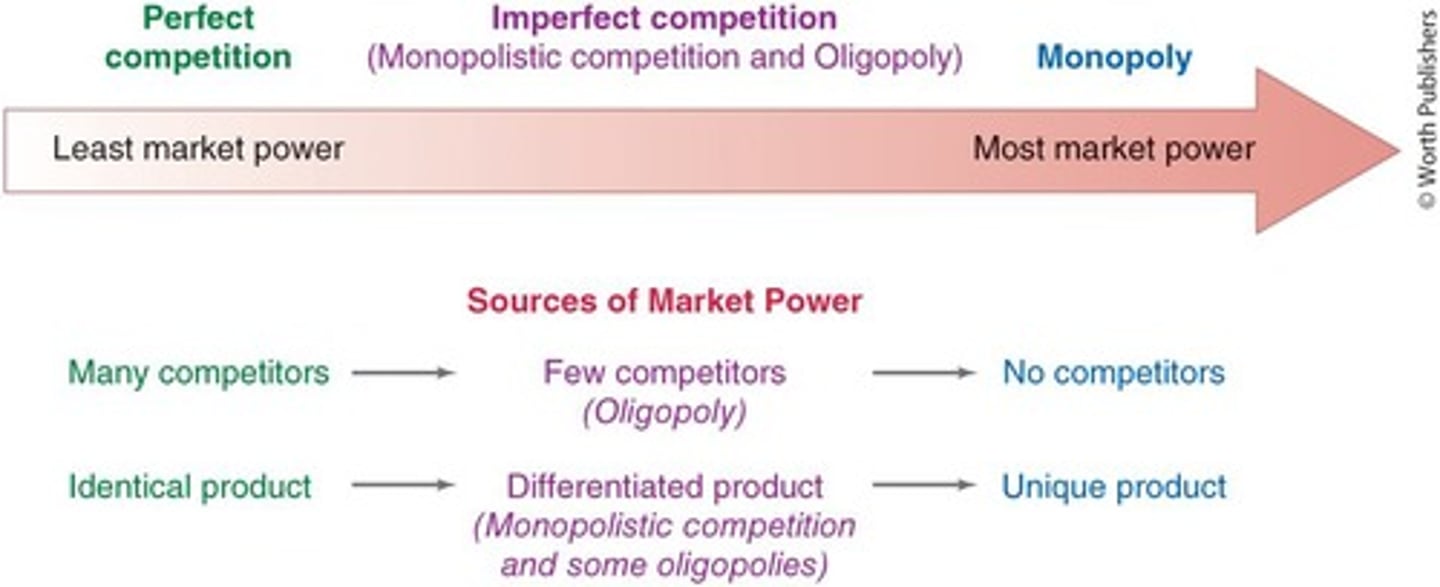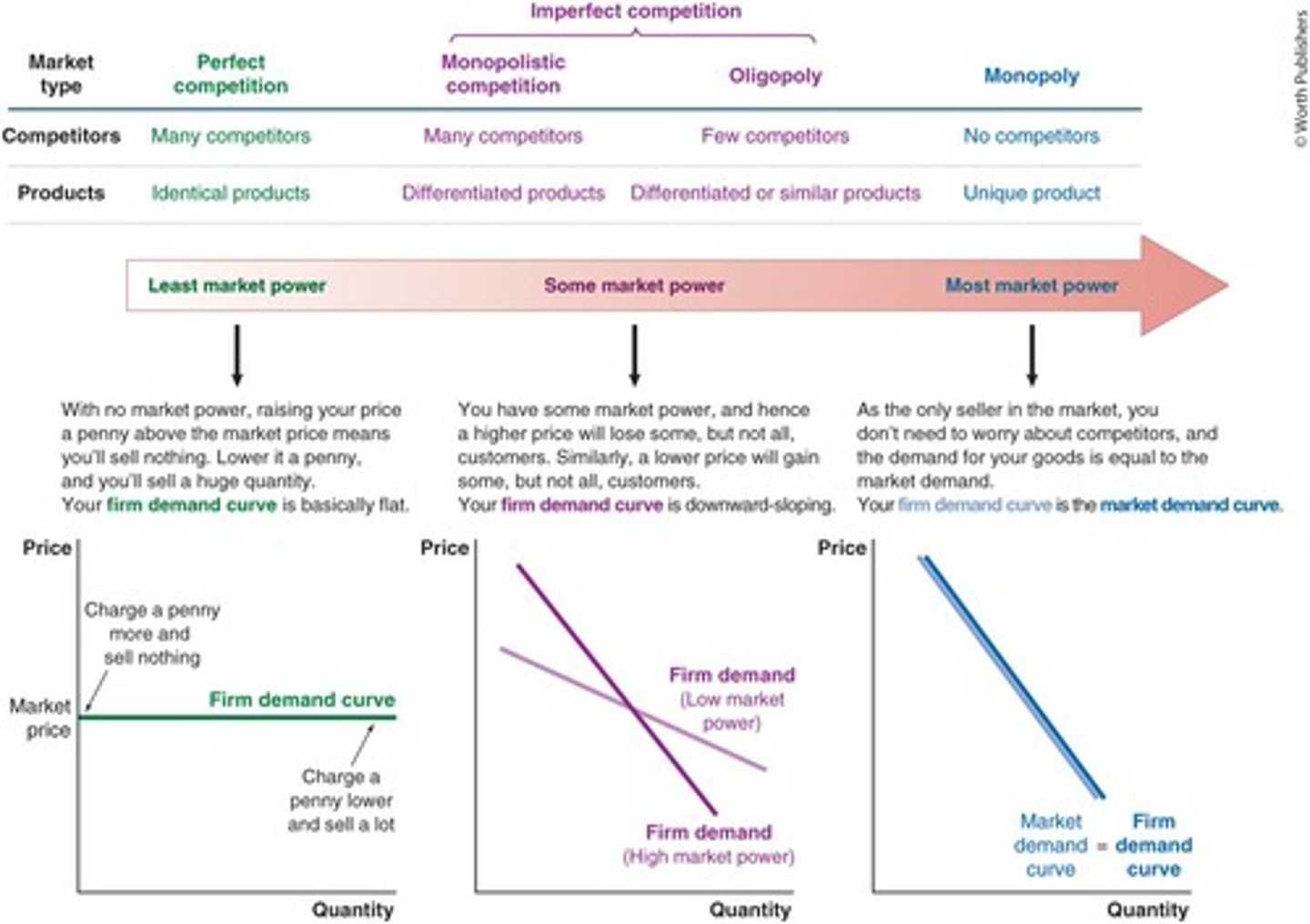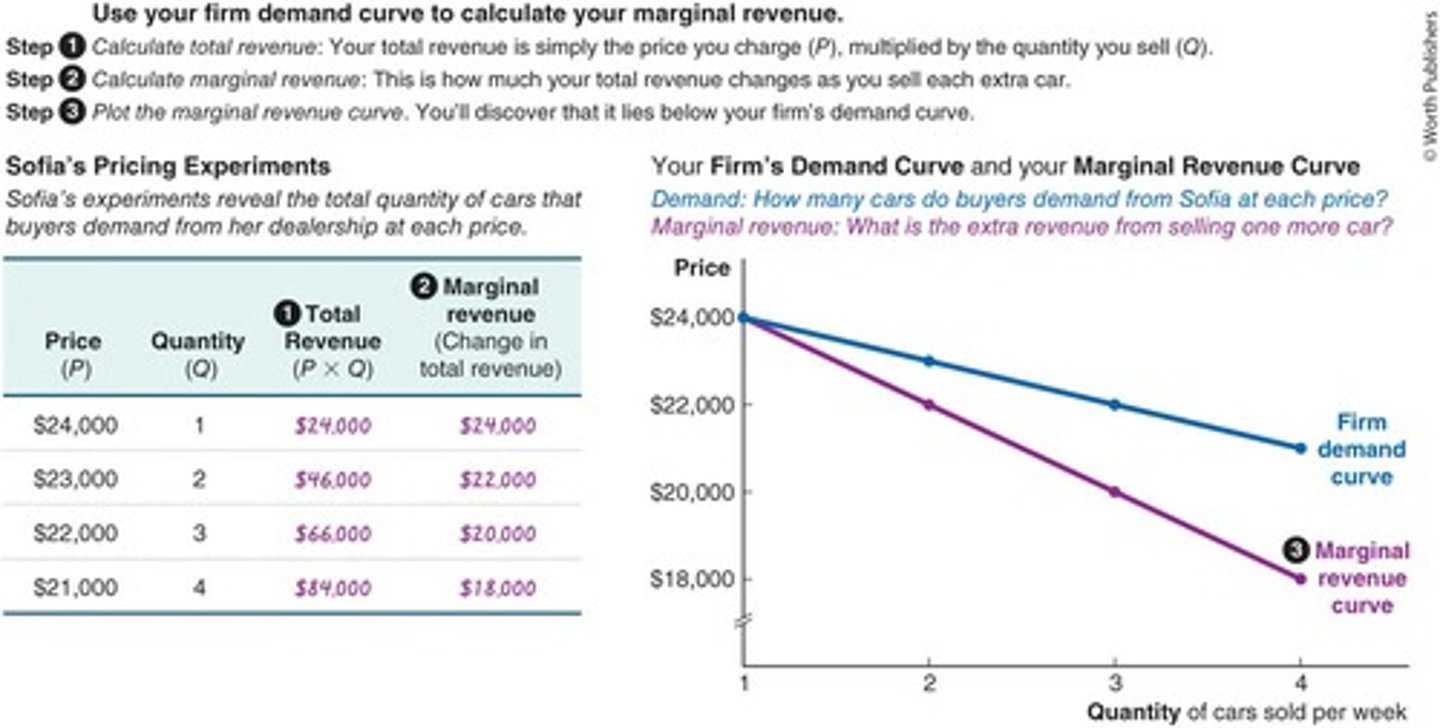Market Structures and Economic Surplus Analysis
1/99
There's no tags or description
Looks like no tags are added yet.
Name | Mastery | Learn | Test | Matching | Spaced |
|---|
No study sessions yet.
100 Terms
Economic Surplus
The extra money you make above your willingness to pay.
Consumer Surplus
Marginal benefit minus price.
Producer Surplus
Price minus marginal cost.
Market Efficiency
Producing a given quantity of output at the lowest possible cost.
Marginal Cost
The cost of producing one additional unit.
Deadweight Loss
How far economic surplus falls below the efficient outcome.
Market Failure
When competitive markets lead to inefficient production and allocation.
Market Power
The ability of a company to adjust their own price due to lack of competition.
Externalities
When the choices that buyers and sellers make have side effects on others.
Information Problems
Private information is not shared equally between both parties, leading to asymmetry.
Marginal Private Cost
The extra costs paid by the seller from producing one extra unit.
Marginal External Cost
The extra cost imposed on others from producing one extra unit.
Marginal Social Cost
The sum of marginal private cost and marginal external cost.
Marginal Private Benefit
The extra enjoyment by the buyer from purchasing one extra unit.
Marginal External Benefit
The extra benefit occurring to others from one extra unit.
Marginal Social Benefit
The sum of marginal private benefit and marginal external benefit.
Socially Optimal Quantity
The quantity that is most efficient for society as a whole, including the interests of buyers, sellers, and bystanders.
Rational Rule for Society
Marginal social benefit equals marginal social cost.
Market Structure
The organization of a market based on the degree of competition.
Pricing Strategy
The method used by a company to price its products.
Output Decisions
Decisions regarding the quantity of goods to produce.
Equilibrium Quantity
The quantity at which supply equals demand.
Positive Externalities
Benefits that affect third parties positively.
Negative Externalities
Costs that affect third parties negatively.
Rational rule for Society
marginal social benefit = marginal social cost
Equilibrium quantity
Forecast what you think will happen find where supply = demand
Externalities
Positive or negative effects involved in a market
Socially optimal quantity
Where marginal social benefit equals marginal social cost
Market failure
Occurs when there is overproduction or underproduction
Market power
The extent in which a seller can charge a higher price without losing many sales to competing business
Perfect Competition
A market with identical goods, many sellers and buyers, and no market power
Price taker
A seller who accepts the market price as given
Monopoly
When there is only one seller in the market with almost absolute market power
Oligopoly
A market with only a handful of large sellers, resulting in substantial market power
Product differentiation
Efforts by sellers to make their products different from those of their competitors
Monopolistic Competition
A market with many small businesses competing, each selling differential products
Marginal revenue
The change in total revenue
Marginal cost
The change in total cost
Total revenue
Price x Quantity
Total cost
Next price x Quantity
Profit
Total revenue - Total cost
Market power outcomes
Market power quantity is less than competitive quantity
AIDS drug pricing
The drug was priced at $10,000 a year despite a marginal cost of less than a dollar
Competition policy
Antitrust policy that encourages competition
Anti-collusion laws
Laws that prevent the destruction of competition in the market
Merger laws
Laws that prevent competing businesses from combining to consolidate market power
Increasing Competition
Can lead to better outcomes, as seen with the AIDS drug price drop after patent expiration
Market outcomes comparison
The price in perfect competition is lower than in imperfect competition
Market Power
The extent to which a seller can charge a higher price without losing many sales to competing businesses.
Perfect Competition
Markets in which identical goods are sold by many sellers and many buyers, resulting in no market power and the seller being a price-taker.
Monopoly
When there is only one seller in the market, resulting in lots of market power and the ability to raise prices without losing customers.
Oligopoly
A market structure dominated by a small number of sellers, where each seller has some market power.
Monopolistic Competition
A market structure where many firms sell products that are similar but not identical, allowing for some degree of market power.
Perfectly Competitive Market Example
Gas Station Example: As one of four gas stations at a busy intersection, you are operating in a perfectly competitive market.
Identical Goods
Products that are the same in every aspect, leading to no differentiation among sellers.
Price-Taker
A seller who accepts the market price as given and cannot influence it by changing their own prices.
De Beers Diamonds Example
From its founding in 1888 until the mid-twentieth century, De Beers operated as a monopolist in the diamond market.

Cellular Service Market Example
The cellular service market is dominated by three sellers: AT&T (45%), Verizon (29%), T-Mobile (25%), and others (1%).
Market Structure
The organizational and competitive characteristics of a market that determine the level of competition and pricing power.
Competitive Environment
The landscape of competition in a market, influenced by the number of competitors and the nature of the products offered.
Pricing Strategy
The method companies use to price their products, which is influenced by the market structure and competition.
Output Decisions
Choices made by a business regarding the quantity of goods to produce, which are affected by market conditions.
Market Structure and Business Strategy
The relationship between the type of market structure and the strategic decisions a business makes.
Strategic Opponents
Competitors in a market that have a significant impact on a business's pricing and market share.
New Competitors
Firms that enter a market and potentially disrupt existing market dynamics by offering similar products.
Higher-Quality Products
Goods that offer superior features or benefits compared to competitors, allowing for potential market power.
Better Service
Enhanced customer service or support that can differentiate a business from its competitors.
Market Power Spectrum
The range of market power that businesses can have, depending on the market structure they operate within.
Agricultural Markets
Markets where many farmers sell identical products, such as corn, leading to perfect competition.
Commodities Markets
Markets where many sellers offer nearly identical products, such as gold, oil, and livestock.
Stock Market Example
There are many people selling Apple stock, and one share of Apple stock is the same as any other share.
Oligopoly
A market with only a handful of large sellers. Products can be somewhat different or somewhat similar.

Oligopoly result
Substantial market power (but less than monopolists). NOT a price-taker.
Strategic interaction
As you choose your price, you think about how your rivals will respond to your choices.
Monopolist Competition
A market with many small businesses competing, each selling differentiated products.
Product Differentiation
Efforts by sellers to make their products differ from those of their competitors.
Market power
The ability to pursue independent pricing strategies.
Imperfect competition
Includes monopolist competition and oligopoly.
Perfect competition
A market structure where no individual seller has market power.
Monopoly
A market structure where only one seller exists for a specific product.
Firm demand curve
Illustrates how the quantity that buyers demand from an individual business varies as it changes the price it charges.

Market demand curve
The quantity demanded across all firms in the entire market at various prices.
Individual demand curve
The quantity demanded by an individual buyer at various prices.
Marginal revenue
The addition to total revenue you get from selling one more unit.
Total Revenue
Price multiplied by Quantity.
Cost-benefit principle
Consider the benefits and costs of selling the additional unit.
Marginal principle
Should I sell one more unit?
Trade-off in pricing
If you lower your price, you sell more units, but you won't make as much money from each unit you sell.
Successful product differentiation
Gives you more market power.
Bargaining power of buyers
Imperfect competition among buyers gives them bargaining power.
Market power and competitors
Having more competitors leads to less market power.
Price setting decision
Key business decision to figure out what price to charge.
Profit margin
The difference between the selling price and the cost of goods sold.
Marginal revenue curve
A graphical representation of marginal revenue as quantity changes.

Calculate total revenue
Total Revenue = Price × Quantity.
Marginal revenue
Your marginal revenue reflects the balance of these opposing forces.
Discount effect
Discount effect = ∆P Q, where ∆P is the price cut you have to offer and Q is the quantity subject to that price cut.
Output effect
Output effect = Price, which is the price of the extra item you sell.
Marginal revenue formula
Marginal revenue = Output effect - Discount effect.
Third car marginal revenue calculation
Marginal revenue = $22,000 - $1,000 2, resulting in marginal revenue from the third car being $20,000.